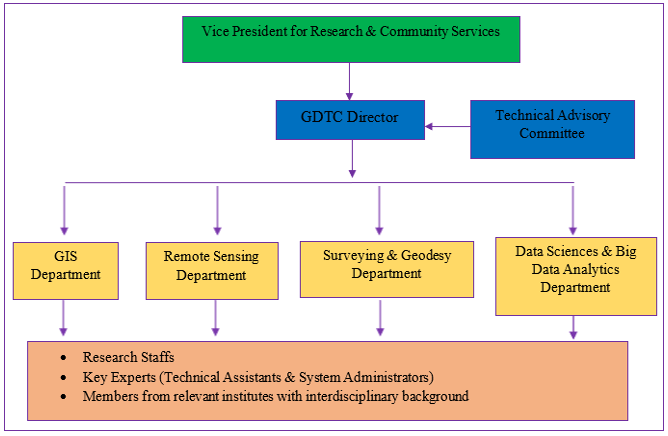GDTC Organizational Structure
The main elements of an organizational structure are work specialization, departmentalization, delegation, chain of command, span of control, and the degree of formalization. Each of these elements affects how workers engage with each other, management and their jobs in order to achieve the organization’s goals.
According to a number of sources, there are six types of organizational structures which include hierarchical, flat, functional, divisional, flatarchy, and matrix. Organizations have a freedom to choose an organizational structure that best suits their needs. Most organizations organize themselves by pyramidal structures with different hierarchy or levels of operation. Such a structure is based on a command and control system.
Hierarchical organizational structure is one of the most common types of organizational structure where the chain of command goes from the top to down and each employee has a supervisor. In this type of structure, top decision-makers occupy the higher levels of the structure, while employees with the least decision-making responsibility are at the lower levels. Such a system has better defined levels of authority and responsibility, allows employees to understand who they should report to, and chain leads to the top decision-maker, motivates employees with clear career paths and chances for promotion, gives each employee a specialty and creates mutual trust and friendship among employees within the same department, and allowing a smooth flow of information across the structure.
In this context, it is a combination of organizational structure and process that shapes university behavior. Universities including BDU incorporate key authority structures, including a governing board at the top, a president, vice presidents, a cohort of administrative leaders, and an academic senate.
The demand for the services offered by the geospatial technologies for different applications, such as utilities, transportation, agriculture, natural resource management, land use planning, defense & intelligence, infrastructural development, and others, has grown significantly over the years. Considering the fact that the technology can completely transform every aspect of the nation’s economy, GDTC aims to address the ever increasing demands towards the geospatial data and technology.
To turn this idea into reality, the re-establishment of the departments namely, GIS, Remote sensing, Geo-Tech & Database, Surveying and Planning, Project & Training that were functioned as separate units based on their specializations is necessary. Taking the current situation in the geospatial technology into consideration, we have made some modifications on the former departments and come up with four departments namely, GIS, Remote Sensing, Data Sciences & Big Data Analytics and Surveying & Geodesy department. The organogram of the reestablished Geospatial Data & Technology Center is shown below.

